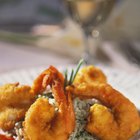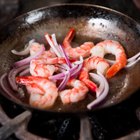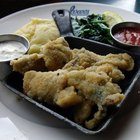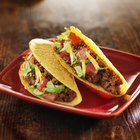
Flour is a key component of making breaded shrimp, whether it's coating the shrimp itself, or acting as a binder to help a heavier coating adhere to the shrimp. Your preference for either breadcrumb-coated, lightly breaded or battered shrimp will determine the flour's prominence in your recipe. Fortunately, for people with gluten sensitivities, there are alternatives to the traditional wheat flour that can be used to make breaded shrimp.
Flour as a Fastener
Flour's essential role in many recipes for breaded shrimp is as a fastener, the base that lets the breading stick to the protein. Straight breadcrumbs, and even the egg or milk wash, would have difficulty sticking to the shrimp on its own. Enter, flour. After patting shrimp dry with a paper towel, coat the shrimp in flour and shake off any excess. Then, dip the floured shrimp in milk or egg and roll it in the final breading. The flour allows each subsequent layer to adhere to the shrimp.
Simply Seasoned Flour
An alternative way to bread shrimp, rather than using breadcrumbs, crackers or panko, is to use well-seasoned flour. The results will be less crunchy, but still flavorful. Coat the shrimp with flour and shake off any excess. Dip the coated shrimp into milk or egg, then dredge it in flour mixed with salt, pepper and any additional spices you prefer, such as Cajun seasoning or Italian spices. If you prefer a lighter coating for the shrimp, skip the milk or egg, and simply dredge the shrimp in seasoned flour. For a bit more crunch, mix the seasoned flour with cornmeal before dredging the shrimp.
Flour as a Batter
For a different texture from breaded shrimp, use flour to create a batter and deep-fry your shrimp. The result will offer a similar crunch, but smoother coating. A simple batter uses egg, milk or water; flour; and melted butter or oil. In reverse order from breaded shrimp, dip the shrimp directly into the batter and allow the excess to drip off. Then, dredge the battered shrimp in well-seasoned flour for a final coating of flavor before frying. For an even fluffier coating, add 1 teaspoon of active dry yeast to the batter for each cup of flour. You can also use 1 1/2 teaspoons of baking powder per cup of flour and 1 to 2 tablespoons of lemon juice. Alternatively, fry the shrimp in 1/2 inch of heated oil in a deep skillet, making sure to turn them so both sides reach golden brown.
Alternatives to Flour
Whether you or your dinner guests are sensitive to gluten, or you simply want to try something different, you have options for breading shrimp that don't involve traditional flour. Coconut flour offers a simple substitute, and can be used in place of breadcrumbs or seasoned flour in most recipes. For a bit of added crunch, mix in unsweetened coconut flakes with the coconut flour before dredging the shrimp. Another alternative is to dust the shrimp in almond flour, dip it in milk or egg and dredge it in almond meal or seasoned almond flour. The addition of coconut flakes works well with the almond flavor, as well.
Related Articles

Can You Deep-Fry Frozen Uncooked Shrimp?

How to Fry Shrimp With Potato Starch

How to Straighten Shrimp for Tempura

Can I Bake Frozen Breaded Shrimp Rather ...
Frying Shrimp in a Light Batter or Flour

Jumbo Shrimp Nutritional Facts

How to Make Breaded Shrimp With Corn ...

How to Cook Shrimp in a Skillet

How to Make Breading Stick to Meat ...

Frying Whiting Fish Using No Flour

Can You Bread Chicken Wings With Egg ...

How to Make Coconut Shrimp

How to Use Panko
How to Cook Atlantic Cod Fillets
How to Cook Boneless Skinless Chicken ...

Can You Substitute Anything for Egg Dip ...

Calories in Hard Taco Shells
Do I Steam or Boil Shrimp?

How to Cook With Coconut Flour for Main ...

Can I Coat Chicken Wings in Cornstarch ...
References
Resources
Writer Bio
Kathryn Roberts has worked in the culinary industry for nearly a decade in various roles, including pastry chef and bakery manager. After studying at the Culinary Institute of America, she earned her BFA from Goddard College and is pursing an MFA in Writing from Vermont College of Fine Arts.
Photo Credits
Jupiterimages/Photos.com/Getty Images